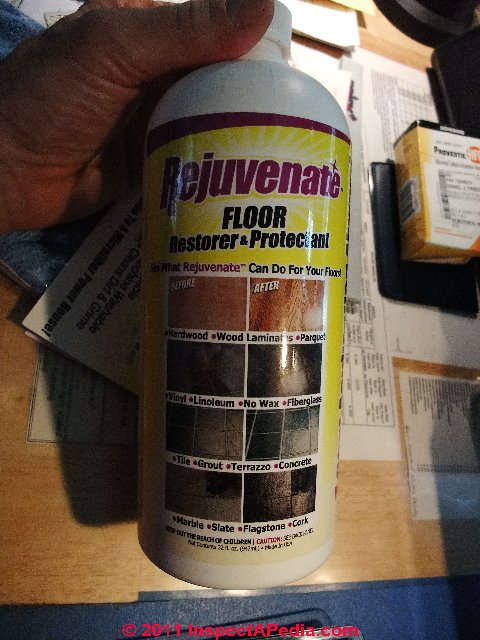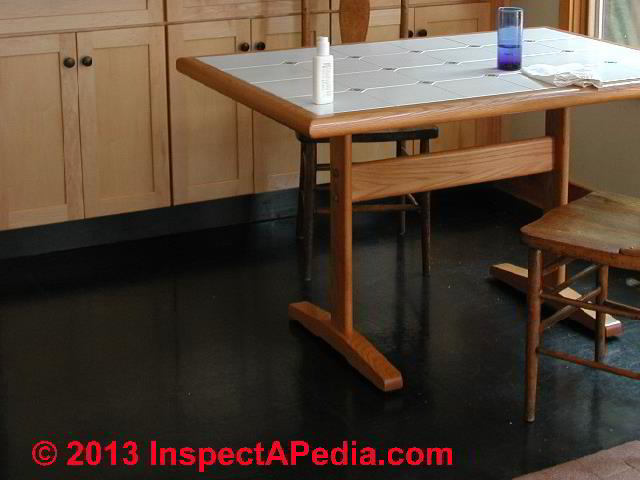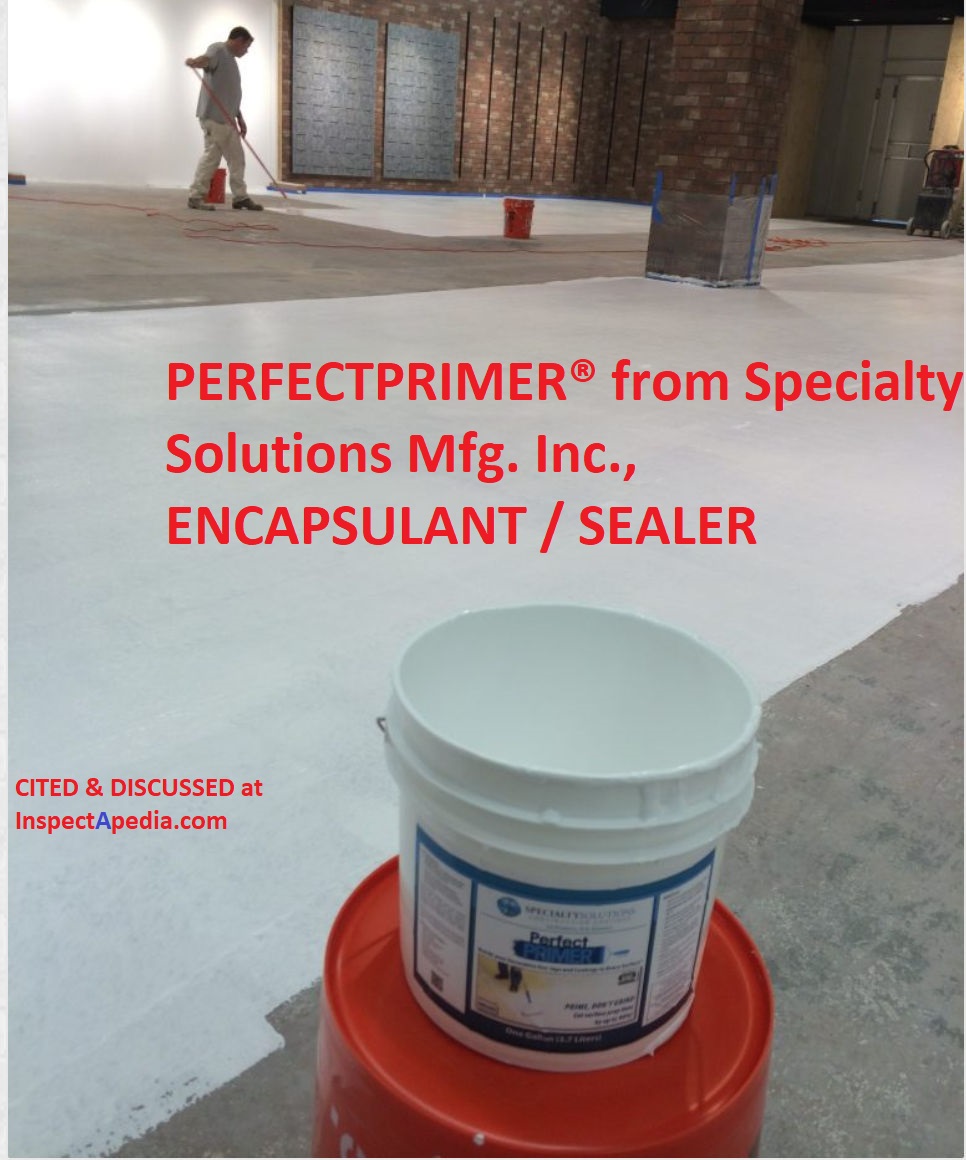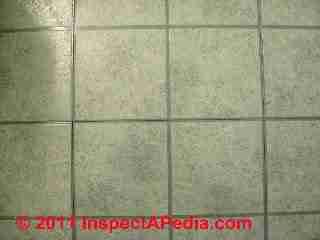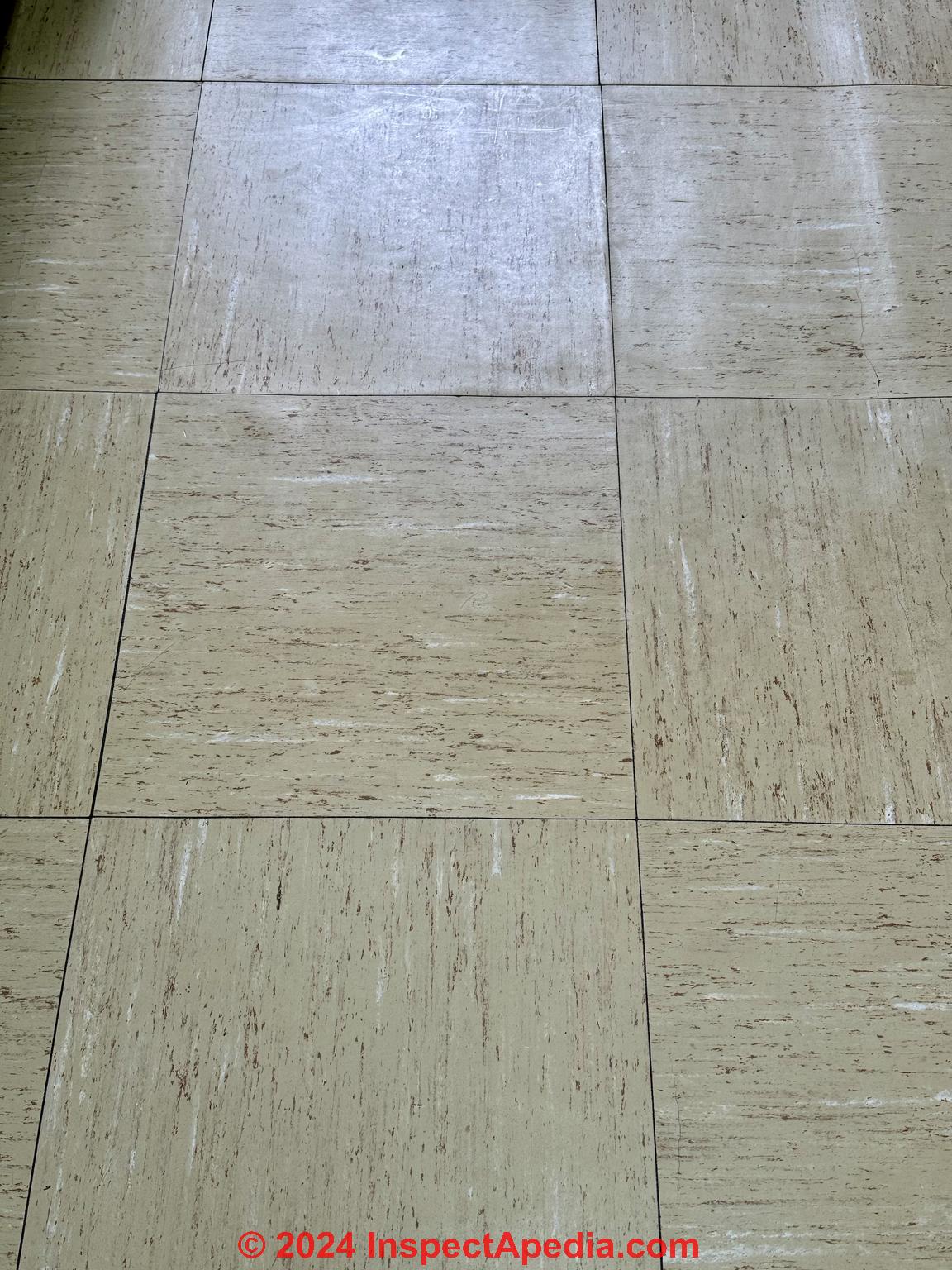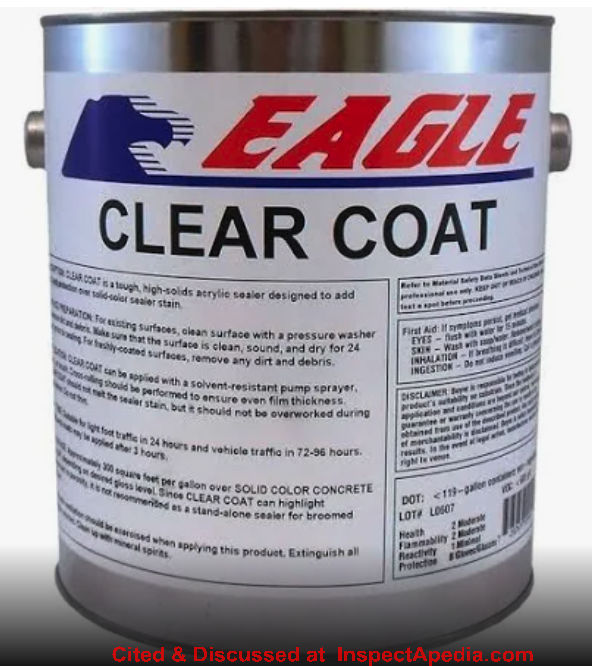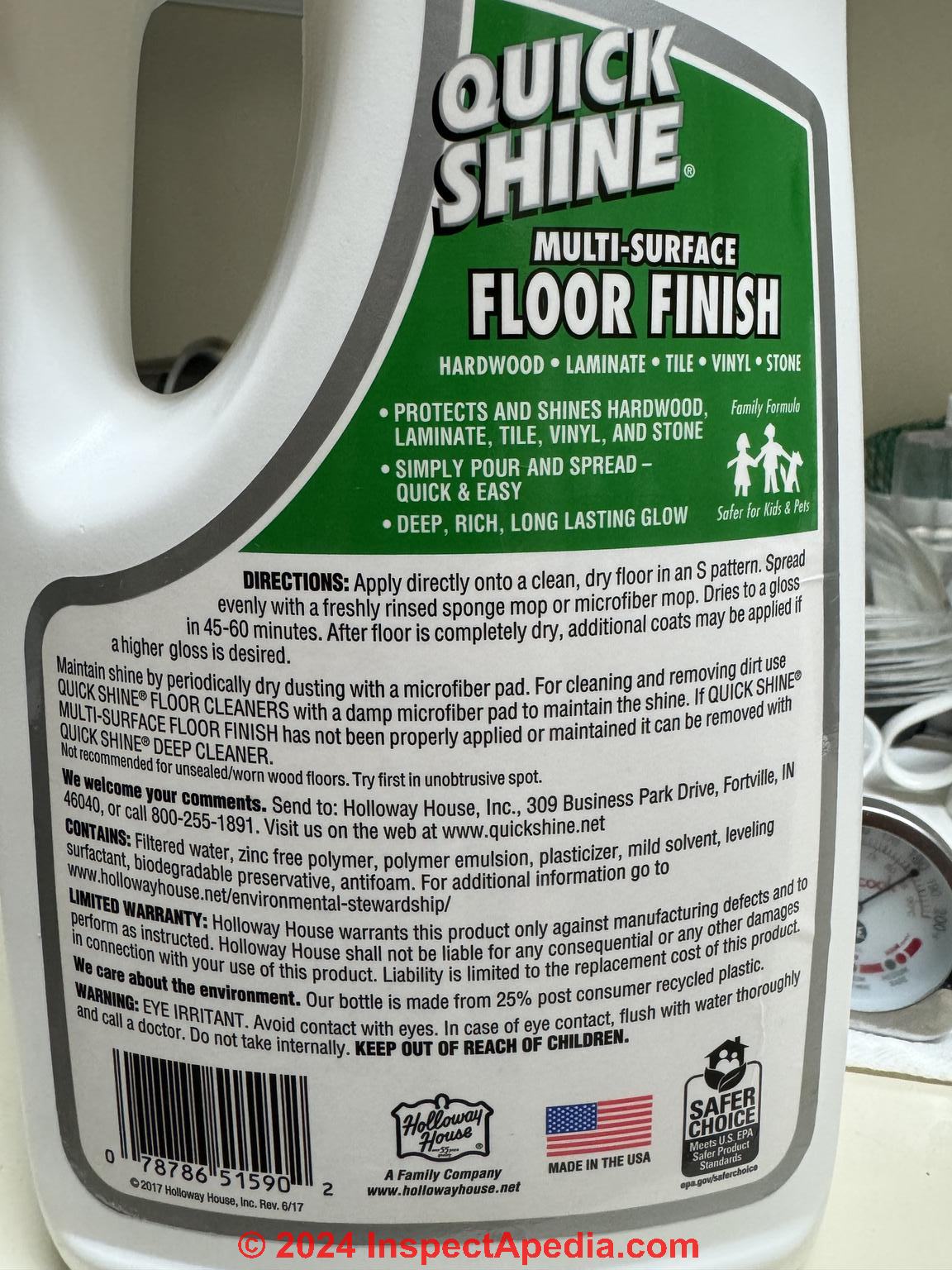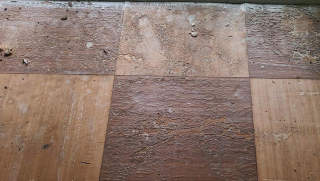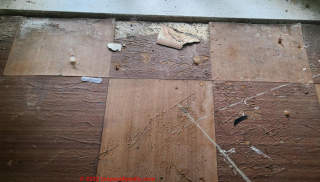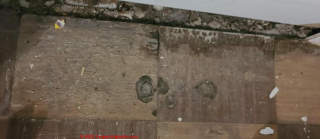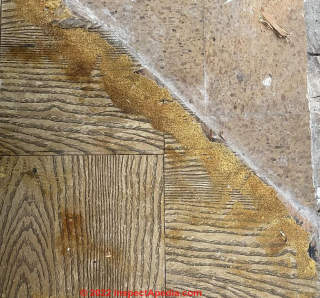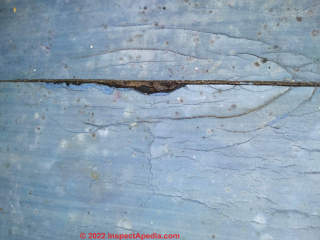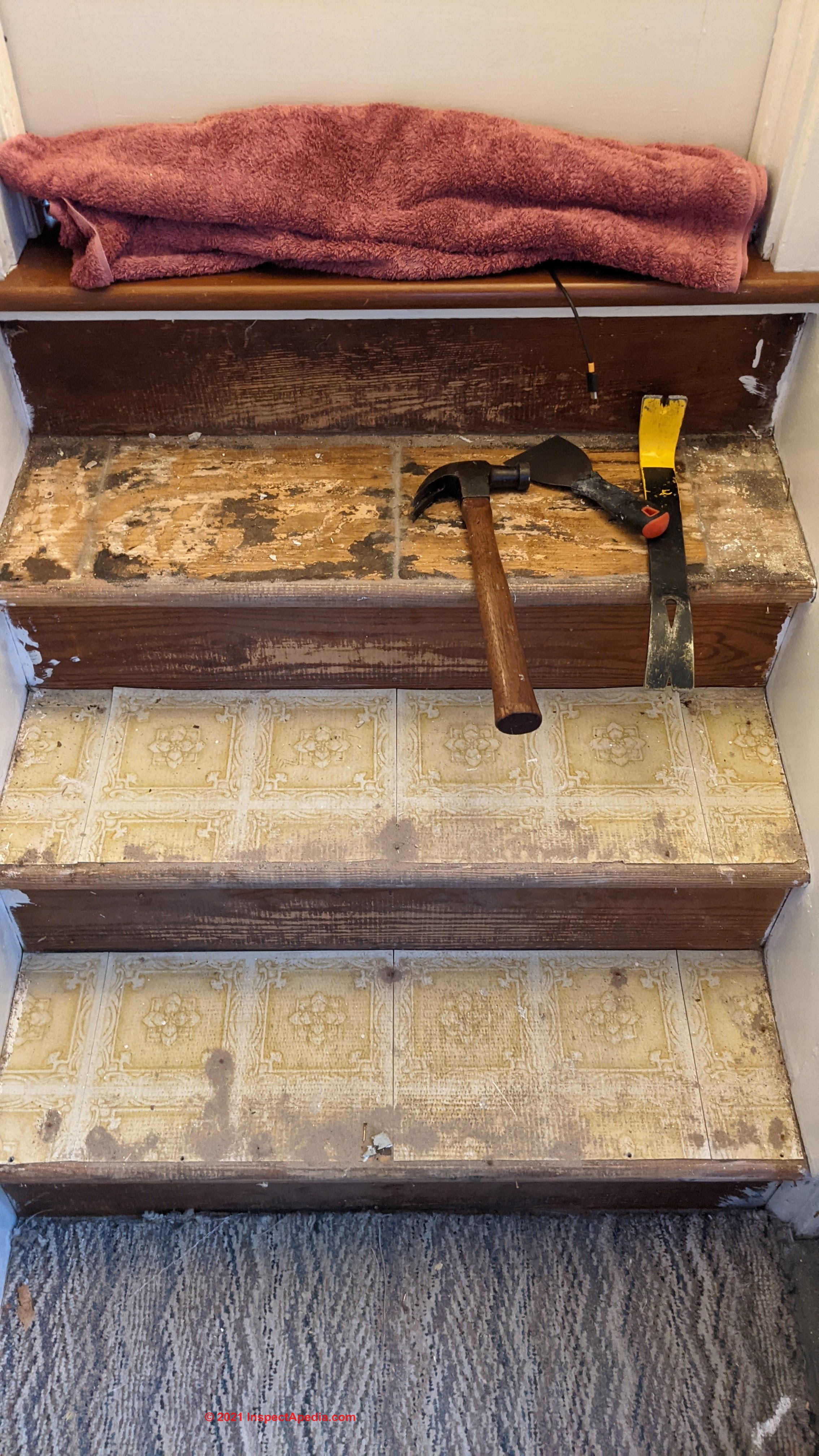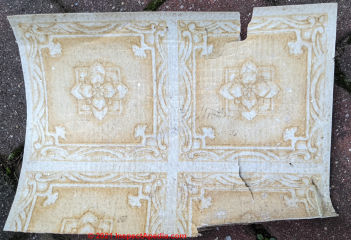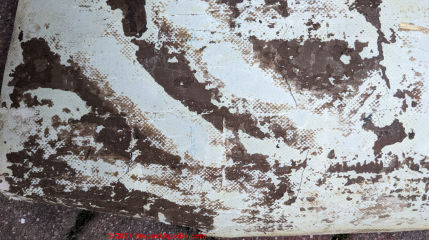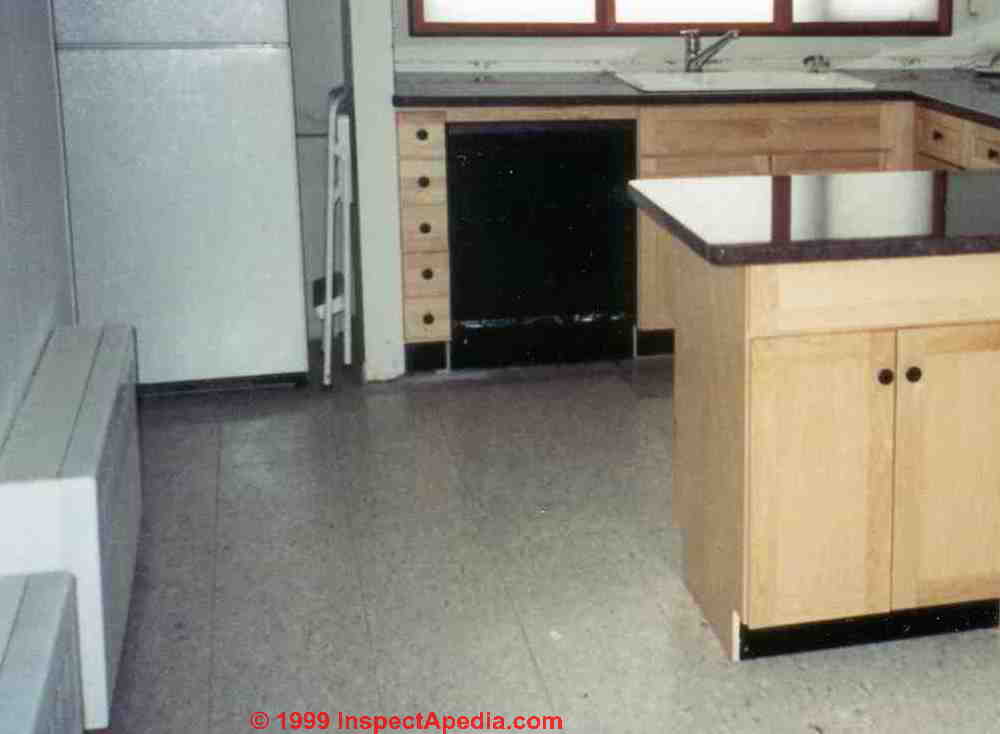 Paint/Seal Asbestos Floor Tiles to Leave In Place
Paint/Seal Asbestos Floor Tiles to Leave In Place
Cover-ups Can Reduce the Hazard of Asbestos Floor Tiles
Epoxy or Acrylic Floor Coatings for
a Safe Walking Surface
- POST a QUESTION or COMMENT On how to minimize the risk of asbestos contamination in a building due to the presence of asbestos-containing floor tiles or asbestos-suspect floor tile coverings
Strategies for leaving asbestos-containing floor tiles or sheet flooring safely in place in a building:
Choosing an appropriate material to cover-up or coat the surface of a sound, well-adhered floor can protect against future damage or asbestos particle release in the building.
We provide photographs and descriptive text of asbestos insulation and other asbestos-containing products to permit identification of definite, probable, or possible asbestos materials in buildings.
Page top photo: vinyl asbestos floor tiles in the kitchen of a 1970's home - before the author painted over the tiles with black epoxy floor paint.
InspectAPedia tolerates no conflicts of interest. We have no relationship with advertisers, products, or services discussed at this website.
- Daniel Friedman, Publisher/Editor/Author - See WHO ARE WE?
How to Safely Leave Asbestos-Containing Flooring in Place
Asbestos was a common ingredient in vinyl and asphalt based floor tiles and in many sheet flooring products in the 1960's up to the mid 1980's or later in most countries.
So the age of your floor combined with the history of asbestos regulations in your country can tell you if old floor tile or sheet flooring is asbestos-suspect
Asbestos can become an airborne particle hazard IF the floor is damaged or is being demolished.
But asbestos is not like something that "emits" a hazard such as radioactive materials. So if the asbestos-suspect material is sound, intact, undisturbed, the risk of particle release is very low.
You can reduce the hazard from asbestos-containing floor tiles by the options we describe here.
Asbestos is safe and legal to remain in homes or public buildings as long as the asbestos materials are in good condition and the asbestos can not be released into the air. - US EPA
Article Contents
- BASICS of LEAVING OLD FLOORING IN PLACE - choice between an acrylic or epoxy paint job vs. covering with a layer of new flooring material
- ASBESTOS FLOOR COVER-UPS THAT WORK - choices among sealants & floor paints versus installing a new layer of flooring or carpet
- STRIP OLD WAX & CLEAN the FLOOR SURFACE - before painting the floor
- COATING or PAINTING ASBESTOS-FLOOR TILE - epoxy or acrylic floor paint demonstration project
...
Basic Advice About Covering or Sealing Asbestos-Containing Floor Tiles or Sheet Flooring
 The safest and most economical renovation procedure for asbestos-containing or asbestos-suspect floor tiles is to leave the old tiles in place, covered by either a suitable floor paint or by installing a new layer of flooring over the existing material.
The safest and most economical renovation procedure for asbestos-containing or asbestos-suspect floor tiles is to leave the old tiles in place, covered by either a suitable floor paint or by installing a new layer of flooring over the existing material.
These options are reasonable even if there is a small amount of damage to the old floor. You'd pick up loose scraps of flooring and, depending on what you plan to do next you may need to fill in missing tiles or small areas where pieces of tile have been lost.
The old flooring that is picked up is enclosed in plastic bags for disposal. Your municipality may permit disposal as construction debris, or you may have to hand it over to an approved waste hauler - double-bagged it should not be an issue. The old floor is damp wiped and perhaps HEPA vacuumed.
Photo above: ceramic tile installed directly over asphalt-asbestos floor tile in a 1970's home.
First let's review the options and basic warnings when leaving an old asbestos-suspect floor covering in place.
- Asbestos-containing sheet flooring: roll up and remove intact.
Vinyl sheet flooring and older linoleum flooring was usually not glued down and can most-often simply be rolled up and removed from the building intact.
You may need to remove corner-round molding around the perimeter of the floor to be able to roll up and remove the flooring.
If the sheet flooring was glued down it's better to leave it in place, covered with a layer of new flooring. - Leave asbestos-containing tile flooring in place & seal its surface.
In residential applications if the asphalt- or vinyl-tile flooring is in good condition you can gently clean, restore, and coat the floor tiles with an epoxy or acrylic paint or (less durable) with a clear restorative coating.
Below we illustrate this procedure using an epoxy floor paint. - Cover the suspect flooring with a layer of new floor material
chosen among examples we list just below
at ASBESTOS FLOOR COVER-UPS THAT WORK.
Above we show ceramic tiles installed over the home's original 1970s vinyl-asbestos floor tiles. - If the floor structure is sufficiently rigid so as to avoid flexing and cracking, ceramic tile can also be installed
over an appropriate subfloor layer - If the asbestos suspect floor surface is in good condition a floor paint is acceptable and low-cost
You can clean and paint the floor if there is little or no loose, broken tiles or if sheet flooring is not not ripped and deteriorating) and if your building is a private residence
(not a school or public space) and not subject to heavy wear or use of mechanical grinders, buffers, etc.,
You proceed by cleaning the floor surface (washing), then painting it with an epoxy or acrylic floor paint,.
In future years, if/when the painted floor surface is scuffed, restore that surface with a floor cleaning and rejuvenation product that adds additional clear coat layers.
Your floor paint can be clear - to preserve the original flooring's appearance, or it can be pigmented for a new look. In our example floor paint job below, the owner was modernizing a 1970s kitchen and wanted a black finish floor surface. - Fill in missing tiles or gaps in the old floor before painting or installing sheet flooring.
For a continuous, smooth surface that is to be left exposed, you might need to use a floor filler over openings left where broken tiles were removed.
Do this if you plan to paint the floor tiles and you may need to do this if you're planning to lay down a new layer of sheet flooring. - Use a HEPA vacuum cleaner
when cleaning up house dust as that type of filter will capture most ultra small particles including asbestos dust if such is even present. Often the installer will damp-wipe the surfaces first and then finish the job with a HEPA vacuum cleaner. - Do not use floor sanders, power or machine driven floor polishers on asbestos-suspect flooring as you'll create hazardous dust.
- Do not permit demolition of a tile floor or a glued-down sheet floor covering
without taking appropriate asbestos-dust control measures - usually a professional remediator or licensed asbestos abatement contractor is required.
...
Asbestos Floor Tile or Sheet Flooring Cover-ups that Work
- Carpeting
(we don't recommend wall to wall carpets in basements nor in bathrooms) - A new layer of resilient flooring,
sheet or tiles, installed directly over the existing floor covering (typically using mastic) provided the current floor surface is smooth and sound - A new layer of resilient flooring, sheet or tiles, installed over hardboard
or other solid underlayment that is placed over the existing floor covering and secured by nails or screws to framing below in order to provide a smooth leveling surface. - A new layer of resilient flooring, sheet or tiles, installed over a pour-on leveling compound
(a concrete mix) used to level uneven floors (most suitable for concrete slab floors, may not be recommended over a wood framed-floor that is not framed solidly enough to resist flexing as the concrete pour-on underlayment may crack) - A layer of epoxy or acrylic floor paint
and one or more layers of clear coat sealant.
This step is described at ASBESTOS FLOORING LEFT IN PLACE-EPOXY PAINT - Coating good condition asbestos floor tiles
with a rejuvenating sealant or gloss topcoat. This approach using an epoxy floor paint is discussed and illustrated just below.
Also see ASBESTOS ENCAPSULANTS & SEALERS - coatings, encapsulants, fiber release control for asbestos containing materials - A layer of ceramic tile
Watch out: We do not recommend installing ceramic tile over a wood-framed floor before you have checked the flexibility of the floor system, in particular if the floor framing covers a larger span, say a dining room, or an area of heavy usage, say an entry hallway.
The worry is that flexing floor framing may cause cracks in the ceramic tile job. Usually the floor can be stiffened sufficiently to avoid cracking either by reinforcing framing from below or by adding a layer of stiff underlayment.
Watch out: when adding a new layer of floor covering that requires underlayment or leveling compound, the increase in floor height where it abuts adjacent flooring of other rooms can create a trip hazard.
...
Stripping Asbestos-Containing Asphalt Floor Tile or Sheet Flooring
 Before sealing or painting-over an asbestos-containing floor that is to be left in place you will need to clean the floor surface of loose dirt and to remove wax coatings so that the sealant or epoxy floor paint will bond to the floor surface.
Before sealing or painting-over an asbestos-containing floor that is to be left in place you will need to clean the floor surface of loose dirt and to remove wax coatings so that the sealant or epoxy floor paint will bond to the floor surface.
To strip old wax and clean the floor in preparation for our final protective top coating, we use a spray cleaner recommended by a floor restorer manufacturer.
The spray cleaner removes old wax residues. See our photo of Rejuvenate™ floor cleaner.
Watch out: do not use any floor cleaning method that involves abrasion, such as stainless steel buffing pads, sanding, grinding, chopping, scraping, NOR solvents that can damage the floor as these may increase the hazard of asbestos exposure to workers and occupants as well as damaging the floor.
Watch out: take care when selecting cleaners or floor stripping chemicals or treatments. Some of these can stain, damage, or even dissolve the flooring.
The following advice on stripping a floor, provided by US Chemical (cited below) was written in general terms and was not intended to apply only to asbestos-containing asphalt-based flooring, but it's still pertinent.
There are 2 types of strippers, alkaline strippers and solvent strippers. Both strippers are diluted with hot water.
Alkaline strippers contain caustics, silicates or monoethanolamine that breaks the polymer bonds of the floor finish.
Strippers containing silicates should not be used on marble, because the silicates can turn the granite gray.
Alkaline strippers can also damage asphalt tiles but are a better choice than solvent strippers on asphalt tiles. Alkaline strippers are generally faster than solvent strippers but need more thorough rinsing.
Solvent strippers contain glycol ethers or alcohols to break down the finishes.
Alcohol based strippers should only be mixed with cold water and should not be used on asphalt, rubber, terrazzo or linoleum floors.
Solvent strippers are the best for stone floors and alkaline strippers are the best for resilient floors.
New tiles have a finish applied during manufacturing, called a mill finish, that needs to be stripped off before the tiles can be sealed or finished.
Solvent based strippers should not be used on tile floors that are less than 2 years old as they can lift the tiles by dissolving the adhesive.
Asphalt tiles (usually 9” squares) should not have solvent based strippers used on them, because the solvent leaches the color of the tile.
Solvent strippers will remove the paraffin from rubber floors, making them brittle.
When used on terrazzo they can leave glycol ether residues, which can be reactivated by a water-based finish. This can strip the floor from the bottom up.
Stripping solution should be applied with a mop and bucket, not an auto scrubber.
If an auto scrubber is used, stripping solution can be left in the scubber, which can damage the scrubber, and then the scrubber can’t be used for the rinse water.
Before measuring the stripper, make sure that the mop bucket is marked with gallon increments. This allows for easy measuring of the stripping solution.
A diluted gallon of stripper solution will strip approximately 600 sq. ft. of floor with an average number of coats of sealer and finish on it. - US Chemical (2016)
- FLOOR FINISHES & FLOOR CARE [PDF] US Chemical, 316 Hart St., Watertown, WI 53094 USA Tel:L (800) 424-1075 Website: http://www.uschemical.com, retrieved 2018/12/03, original source: http://www.uschemical.com/wp-content/uploads/2016/04/L000238_FLOOR_FINISHES_FLOOR_CARE_BR.pdf
Stripping & Cleaning an Asbestos-Containing Floor Covering
When sealing vinyl-asbestos tile floors, especially in residential use where school or public regulations and public access worries don't apply, we've had great success using epoxy paints but you may find a shorter-term less durable but safe coating using clear-coating floor restorer products.
There are two different circumstances:
- If you are simply going to clean an existing, uncoated asbestos-flooring surface and apply a floor restorer/coating (no painting)
like the Rejuvenate product shown in our photo above you will need to repeat the cleaning (cleaner product photo above)
and re-coating (floor restorer protectorant coating product shown below) from time to time. - If you have previously painted your asbestos floor surface with an acrylic or epoxy top coating
you may still need to clean and rejuvenate that surface from time to time.
...
Acrylic or Epoxy Coating for Asphalt Asbestos Flooring
or Vinyl Asbestos Floor Tiles Using Epoxy Paint and/or a Rejuvenation Sealer or Gloss Coat
Our photographs demonstrate the use of an epoxy floor paint to provide a durable and safe coating for a vinyl-asbestos tile kitchen floor that was otherwise in good condition.
The original asbestos floor (shown above), installed when the home was built in the 1970's, was cleaned to provide a good bond for the epoxy floor paint.
No sanding, grinding, or other dust-producing methods were used.
The original epoxy paint coating was made in 2000; the photo above shows the condition of the floor around 2025, more than two decades later.
4 Steps in Coating & Maintaining an Asbestos-Containing Floor Surface with Acrylic or Epoxy Floor Paint
We did this recently in a New York home where we had previously stripped, cleaned, and painted the floor with an epoxy floor paint. We followed this procedure:
- The floor is washed
with mild detergent and water.
Watch out: take care when selecting cleaners or floor stripping chemicals or treatments.
Some of these can stain, damage, or even dissolve the flooring. - Then we use a spray cleaner recommended
by the floor restorer manufacturer. The spray cleaner removes old wax residues. See our photo of Rejuvenate™ floor cleaner
at STRIP OLD WAX & CLEAN SURFACE. - We paint the floor
in this example and as the homeowner preferred, we used a black epoxy floor paint applied directly to the cleaned surface of the old floor tiles.
We could have used another color and we could have used an acrylic floor paint instead of epoxy.
If we'd wanted to preserve the appearance of the original floor tiles we'd choose a clear epoxy or acrylic floor coating.
The floor looked new, and great (photo below).
- For renewing this floor in future years we then used a black magic marker
to color in some gouges that had marred the black epoxy-painted floor surface and then
we coated the flooring with the floor restorer product using the floor rejuvenation products discussedat STRIP OLD WAX & CLEAN SURFACE BEFORE PAINTING or SEALING ASBESTOS FLOORING
if you maintain a hard clear coating on top of the floor surface you won't be releasing any measurable level of asbestos fibers by normal foot traffic.
Watch out: We advise against using any power equipment such as sanders, grinders, saws, or even steel-wool buffers on vinyl-asbestos flooring out of concern for the effect of grinding of the surface and concomitant release of asbestos particles into the building air.
In sum, provided that your floor tile is not damaged and remains soundly glued in place, in residential use it may be fine to seal its surface and leave it alone.
...
Paints & Floor Sealants for Floor Tile Mastics / Cutback Adhesives
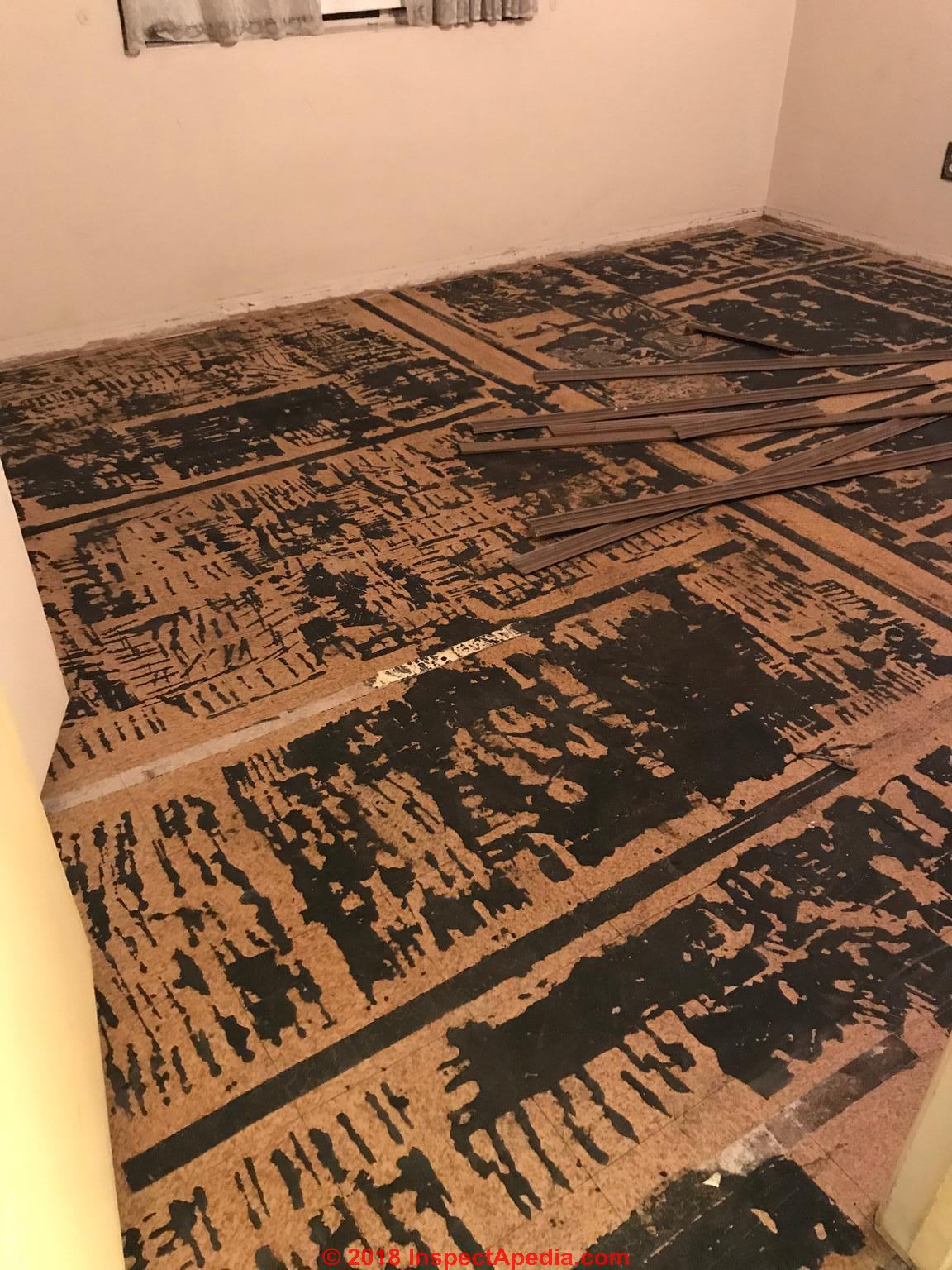 Where some or all old floor tiles have been removed the floor tile adhesive, also called cut-back adhesive or tile mastic will remain, as you can see in this photo provided by our reader Rachel.
Where some or all old floor tiles have been removed the floor tile adhesive, also called cut-back adhesive or tile mastic will remain, as you can see in this photo provided by our reader Rachel.
Removing old floor tile cutback adhesive is a horrible job that you should avoid in favor of covering the floor with resilient tile or sheet flooring, carpeting, engineered wood, laminate flooring or a similar product.
We can install a new layer of flooring directly atop the old exposed remains of adhesive or mastic like that shown in the photo just above.
Optionally, we may choose to paint that whole surface with a primer/sealant specifically formulated to paint over old adhesive.
Those products are listed at ASBESTOS ENCAPSULANTS & SEALERS
However there are at least two situations in which we need to paint-over and seal exposed floor tile adhesive even for a floor we intend to cover.
- We intend to paint-over spots where floor tiles were removed
(with epoxy floor paint) and keep the original tiles in place without adding new layers of flooring, but there are a few areas where tiles lifted or were removed, exposing the floor tile mastic.
Before gluing down replacement tiles in preparation for epoxy-painting we might want to prepare the old mastic-coated surface to be sure that the replacement floor tiles will remain glued in place.
You can glue new floor tiles down over a thin coating of encapsulant paint such as those described
at ASBESTOS ENCAPSULANTS & SEALERS
- We need to level spots where floor tiles were removed
so that variations in the original floor surface don't telegraph up through a new layer of resilient sheet flooring to be installed.
Here too we want to prepare the old mastic-coated surface to be sure that the floor leveling compound we apply, or fill-in floor tiles that we stick down will remain in place beneath the new resilient floor.
We may simply glue in a floor tile of the right size, or we may use a filler or leveling compound to fill more-limited spaces where floor tiles or pieces of them are missing.
Using leveling compounds or glue-down filler tiles to level out an old tiled floor prior to covering it with resilient sheet flooring or epoxy paint is described
at FLOOR TILE BASE LEVELING
If there are just a few holes or small voids such as where carpet tack strips were removed, we may use a product like the Durham's Water Putty shown above, followed by a sealant paint.
For another approach to sealing a damaged asphalt- or vinyl-asbestos tiled floor that's uneven and damaged,
see POURED-IN-PLACE FLOORING, RESILIENT - pour on a whole new floor surface
Three floor tile mastics / cutback adhesives you may encounter
Black Asphalt-Based Floor Tile Mastic
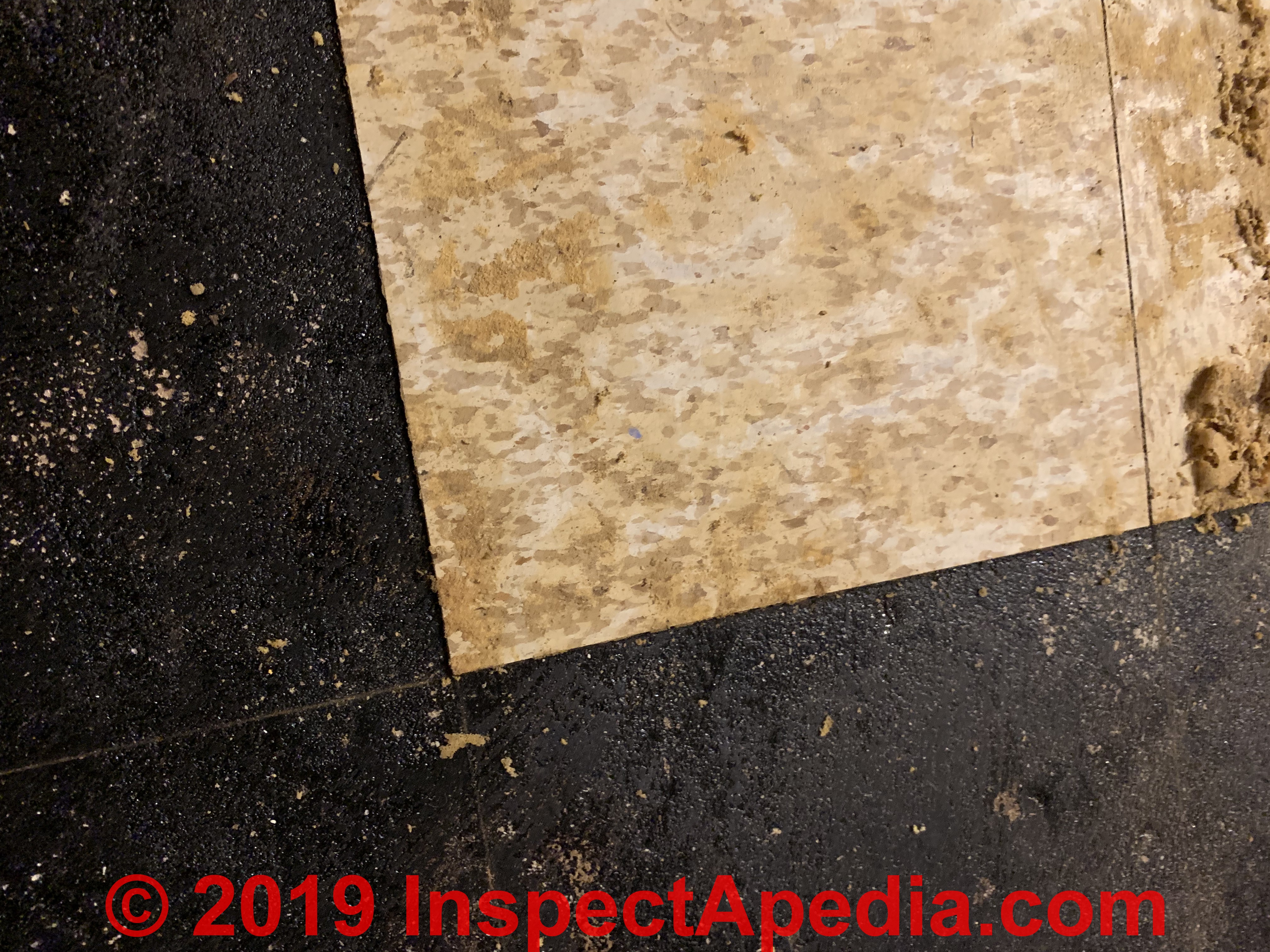 Black asphalt-based floor tile adhesive, often containing asbestos.
Black asphalt-based floor tile adhesive, often containing asbestos.
This material is not friable unless some fool runs a power sander or scraper over it. Although it can be partly removed using organic solvents, that approach is dangerous and unnecessary unless you are trying to restore a historic and valuable wood floor below.
Instead it's better to leave this adhesive in place and to cover-over the floor with new flooring materials.
If the floor is to be covered with a new layer of flooring
such as sheet vinyl or vinyl tiles or even carpet padding and carpeting, there is essentially no risk that asbestos particles can move up from the old floor into the occupied space; nothing is abrading the old asbestos-containing floor tiles and they're covered by a membrane of one or more layers of new material
If however you do not want to add more layers of flooring material
another option is to clean and seal the original asbestos-containing floor tiles using an epoxy paint designed for use on floors. I've found that that treatment is very durable - having tested our original installation in a building for nearly twenty years.
Tan or Brown Solvent-Based Floor Cut-Back Adhesive
Solvent-based tan floor tile mastic: Some tan or brown colored floor tile or resilient flooring adhesives were organic-solvent based and can be dissolved and scraped up but the process is difficult, involves working with potentially dangerous solvents, and is probably a bad idea.
Tan or Brown Water-Based Flooring Adhesive
Water-based tan or brown floor tile adhesive: Some tan or brown-colored floor tile or sheet flooring adhesives were water based and can be dissolved and scraped up using simple water.
I [DF] removed water soluble tan floor tile mastic in a small area at an entry door in Wappingers Falls, NY after first trying odorless paint thinner, lacquer thinner and other terrible stuff.
To my shock water took the adhesive right up.
But this was an exception to the general experience.
Below: PerfectPrimer® being painted over an old floor surface with cut-back adhesive, adapted from the company's literature.
Watch out: some primer/sealer paints and possibly some floor leveling compounds will react with or partially-dissolve or bleed-through or bond poorly with tile mastic adhesives, particularly asphalt-based adhesive. Be sure that the products you use are described by their manufacturer as suitable for painting over floor cutback adhesive.
...
Guides to Managing Asbestos Left in Place in buildings
Moved to: ASBESTOS LEFT in PLACE in BUILDINGS - MANAGEMENT GUIDES
...
Reader Comments, Questions & Answers About The Article Above
Below you will find questions and answers previously posted on this page at its page bottom reader comment box.
Reader Q&A - also see RECOMMENDED ARTICLES & FAQs
Reader Question: Armstrong asbestos floor tile die cut inserts from around 1952 - ways to seal these floors?
Am looking for information on Armstrong diecut inserts from around 1952.
Also are there any recommended ways to seal these floors so you can enjoy the look but without any asbestos concerns? Thanks, Sarah - Sarah 6/23/11
Reply by (mod): gentle cleaning followed by floor restorer clear coating protects from asbestos fiber release
Sarah:
Our photos show examples of some of the die cut flooring inserts from the 1950's; I'm not sure what other information you seek.
About sealing vinyl-asbestos tile floors, especially in residential use where school or public regulations and public access worries don't apply, I've had great success using clear-coating floor restorer products.We just did this recently in a New York home. The floor was washed with mild detergent and water. Then we used a spray cleaner recommended by the floor restorer manufacturer.
The spray cleaner removes old wax residues. Next we used a magic marker to color in some gouges that had marred the floor surface. Finally we coated the flooring with the floor restorer product. The floor looked new, and great.
In sum, if you maintain a hard clear coating on top of the floor surface you won't be releasing any measurable level of asbestos fibers by normal foot traffic.Also see ASBESTOS FLOORING HAZARD REDUCTION for more ways to reduce the asbestos hazard in asbestos-suspect or presumed asbestos-containing flooring.
Reader Question: What are the options for covering asbestos-suspect floor tiles or sheet flooring?
We are renovating a small bathroom that has resilient flooring of uncertain age, but from the style we think the floor tiles are from the 70s.
We want to cover this floor tile to avoid an asbestos hazard. What are some options. - Anon.
Reply: asbestos-containing flooring in good condition is not "radioactive" and does not spontaneously emit harmful particles
Remember that the hazard from asbestos-containing floor tiles is not like something that's "radioactive" - if the flooring is not damaged, if you avoid making a dusty mess by demolition, and more, if it the flooring can be covered and protected from damage, it is not harmful if left in place.
Current best asbestos advice is to avoid the dust and mess of demolition of vinyl asbestos flooring if you can simply cover it with another material.
Question: how can we identify these 1950's 9x9" basement floor tiles to find out if they're "asbestos" ?
 We are planning to gut and remodel a basement in a house we have been living in for a few years now. The basement previously was used just for storage, but we want usable space there. About 400 Sq ft of the 700 we will be remodeling has existing tile while the rest is just painted cement floor.
We are planning to gut and remodel a basement in a house we have been living in for a few years now. The basement previously was used just for storage, but we want usable space there. About 400 Sq ft of the 700 we will be remodeling has existing tile while the rest is just painted cement floor.
Some of the tile is missing, one section cracked, but covered with foam play mats, which my wife installed initially when the house was purchased.
These are 9x9 tiles, and we have no idea about history or age.
The house is a 1950s home, but it is not clear when the basement tile was installed. A search online lead me to your site, and they do look like Armstrong tiles possibly, but I wanted to get an opinion from somebody with more expertise.
Me plan was to have the floor removed and to go with an epoxy floor covering, as it is a basement floor, where water is always a possibility and carpet is not something we want to risk.
If it is not advised, and it would be better suited to go with a different floor covering, we would still need to deal with the areas missing tile, but we have a contractor that can aide in this.
I will attach some photos that hopefully can help identify the tiles in question. - Anonymous by private email 2018/06/02
Reply: asbestos-containing flooring does not mean we have to undertake an expensive and dangerous asbestos removal project
You will find an exact match to your flooring in the ID-library of asbestos flooring beginning
at ASBESTOS FLOOR TILE IDENTIFICATION PHOTOS 1949-1959- (floor tiles) where you'll see your flooring in the early Armstrong (or similar manufacturers) vinyl asbestos or asphalt asbestos 9x9" (and other sizes) flooring.
Do you need to test the floor for asbestos?
From the age and appearance of the floor, I would not bother testing it for asbestos, spending instead on proper cleanup and sealing of the surface.
Even without testing, given the appearance and known age of your floor, it would be prudent to treat such flooring as "PACM" or "Presumed Asbestos Containing Material".
The presence of known asbestos-containing flooring does not mean we should panic nor that we should undertake an expensive and dangerous asbestos removal project.
Do you have to remove the existing floor tiles?
Asbestos is safe and legal to remain in homes or public buildings as long as the asbestos materials are in good condition and the asbestos can not be released into the air.
Generally the safest approach is to leave such flooring alone and to cover it with a coating or with another layer of flooring.
Keep in mind that even if you removed the floor tiles the remains of the mastic adhesive below would make use of an epoxy floor paint problematic - it may not properly adhere. You'd need to also remove the adhesive (which may also contain asbestos), and then clean the surface to make it bond with the floor paint.
All of that demolition and cleaning, performed properly and safely, would be quite costly. If the rest of your floor is sound and well-adhered, that expense is probably not necessary.
Options for leaving the flooring in place
For the situation you describe,
see ASBESTOS FLOORING LEFT IN PLACE where I describe using an epoxy coating on a floor in generally good condition and provided that the remaining floor tiles are well-adhered to the floor below.
You can buy floor tiles that can fill-in the voids in the existing floor. Select a floor tile of the same thickness and surface texture (not embossed). Armstrong as well as other floor tile manufacturers sell floor tiles in various thicknesses, one of which should match the thickness of the existing tiles.
Other advice on various options for an asbestos-floor tile is
at ASBESTOS FLOORING HAZARD REDUCTION
For a floor whose tiles are well adhered except for small areas of damage such as you show, I would prefer to damp-wipe clean up a few broken tiles, replace missing ones with new tiles of the same thickness, then epoxy-seal or otherwise cover-over (sheet vinyl) the existing floor.
If you must remove the 9x9 asbestos-suspect flooring
Watch out: If when you remove the rest of the current covering over the floor you find a significant number of loose, poorly-adhered, or broken floor tiles, OR if for other reasons you are compelled to remove the floor (not the recommended option)
see ASBESTOS FLOORING REMOVAL GUIDE .
Watch out: Do not run a conventional vacuum cleaner over such areas as you'll just cause more particles to become airborne.
On any of our asbestos-related InspectApedia pages, at CONTINUE READING you will find
a complete ARTICLE INDEX to ASBESTOS HAZARDS
For advice on handling irregularities in floor surface after loose floor tiles have been removed see
RESILIENT FLOORING VINYL or CORK
We would have much appreciated hearing any comments, criticize, suggestions, or further questions that you may have taken after you've taken a look at the articles I've cited.
InspectAPedia is an independent publisher of building, environmental, and forensic inspection, diagnosis, and repair information provided free to the public - we have no business or financial connection with any manufacturer or service provider discussed at our website. We do not sell products nor services.
Reader question: how do I properly seal my asbestos floor tiles
Old building (1930"s) but moved in to just fully renovated rental in 1995. My floor (12x12" tiles) is in good shape well fixed to the underfloor. I've been stripping and sealing every 7 years or so with Hollaway products for 29 years. Never thought of asbestos.
There is some dark brown (not jet black) adhesive visible in some seams but the main concern is the pattern which seems to be like the older VAT tiles (in some of your photos (probably not asphalt) When stripped no discoloration or oily appearance.
Is there a chance that these tiles could be VCT rather than VAT? or is it possible these were old stock tiles? The floor is about 48 sq feet. I realize a test is probably prudent but if I do a proper seal - more coats of acrylic would that be the best option even if testing reveals asbestos? 2024-08-04 by Adele
Reply by moderator:
@Adele,
There were some older 12x12 floor tiles that did not contain asbestos but basically would be prudent to treat the floor as presumed to contain asbestos.
As long as it's in good condition it's safe and legal to leave it in place. The best approach if you want to continue to see the floor pattern is to seal it. I've used clear epoxy sealers and similar products with good success.
If you had to demolish the floor and therefore risk to producing hazardous dust, then it would be appropriate to have a sample tested.Reader follow-up:
@InspectApedia Publisher,
Thanks for such a quick reply. I've looked at your suggested epoxy and primer and I don't really have an aversion to covering the pattern, but it seems like a job for a professional even if just clear epoxy.
I will need to get the landlord involved for any major change...so I was originally hoping to just add more layers of acrylic floor protector DIY-style. Sounds like you are suggesting a more complete seal than average pour-on acrylic finish.
If so, I can skip the test and ask the landlord if they can at least refer me to a contractor who can do a nice smooth epoxy job or even a floating laminate floor, if they approve, I will pay. They may also offer to test since I am sure they do that all the time when renovating.
The main thing is I need to disclose my concerns because they own the unit, and if anything gets covered they would need to be aware of potential future abatement when renovating, correct?
Best thing is full transparency for everyone's health and safety.
Thanks so much for helping me sort out best suspected asbestos practices! The unwarranted fear is gone. Your site is such a great positive help - I am sure there are more and more people discovering the shocking prevalence of asbestos in past construction.Reply:
@Adele,
I apologize: I should have made clear (excuse the pun) that any clear coating that is designed for use on floors would be fine. I like epoxy for its long term durability, but an acrylic floor coating (clear) would be perfectly fine to use as a top coat sealant to put an end to any worry about shedding or damage from an asbestos-containing floor tile that's otherwise in good shape.
An example is the Eagle clear floor coating shown here and sold at Home Depot - at about $35. / gallon
Please take a look at our article above on this page.
Thanks for a helpful question. Don't hesitate to ask any follow-up you want.
Daniel
Reader follow-up:
@InspectApedia Publisher, Thanks so much for your suggestion, and your time....I wonder if I could use the product I have used in the past which seems to put a very durable satin/gloss finish on the tiles - when applied in multiple thin layers and dried fully in between coats.
The reason I ask is that an oil based product like Eagle would be overwhelming in my small apartment and the cleanup and dry time is a huge problem as disposing of this kind of material isn't easy in NYC.
Reply:
@Adele,
I think that's perfectly fine.
My opinion is that in a light use residential environment such as what you've described it's probably the case that asbestos containing floor tiles don't shed a detectable level of airborne asbestos in the first place.
To be safe we like to clean the floor and coat it when it's in good condition such as you have described.
If you're going to use a less durable coating then those heavy duty ones that I discussed earlier it may simply mean that you need to keep an eye on the condition of the floor surface and to clean it and re-coded a bit more frequently.
Reader follow-up:
@InspectApedia Publisher,
Update - I decided to have professional inspection to ease my mind, found a great certified and EPA registered firm that doesn't do abatement. Everything you mention here on Inspectapedia was confirmed.
The inspector was not at all worried about the tiles, or the adhesive which he doubted was black mastic. He didn't even take a sample (to save me money) since the outcome would be the same either way, He saw my bottle of floor finish and was totally fine with more acrylic coats just as you were in your last reply.
He did take a sample of my popcorn ceiling - (will update in the appropriate page) when I get results. It had been painted over in 2017 and in good condition but he thinks it would be good to know and protect myself or maintenance workers if any repairs ever became necessary.
Thanks a million for what you do here on Inspectapedia!Reply:
@Adele,
Thank you so much for the update. And thank you also for the generous comment. We worked hard on this material for decades so we're very grateful when our website and content are found useful and trusted.
Do let me know about your ceiling test results.Reader follow-up:
@InspectApedia Publisher, Popcorn ceiling "no asbestos detected" Hooray. 1995 renovation of an apartment in a 1930's building. It was worth the price to have piece of mind - everything I have read still warns that old popcorn texture was possibly still around in warehouses and being used up into the 1990's even though banned. Highly recommend an independent inspector in your location EPA certified. Inspectors have no interest in selling you abatements - they are plenty busy testing and monitoring building sites, demolitions, , renovations and public spaces. Thanks again, Daniel. your site is an important educational tool for renters and buyers along with homeowners to avoid the risks of dangers and abatement expenses in home renovation.
Reply:
@Adele,
Thank you for the follow up and for the good news about the asbestos test on your popcorn ceiling paint.
Thank you also for your generous words about our website. We've worked hard on this information for decades so we're always very grateful when readers find it helpful and trusted. Unfortunately Google's recent search engine updates have preferred sending people with questions to pages with simpler answers then those that we think are most useful.
On 2022-09-19 by Keegan - Can I use an encapsulating paint over my asbestos floor tiles in in good shape - after cleaning?
I am redoing a small 13×18 office in my house. The majority of tile is in good condition and I plan to encapsulate with ABC or perfect prime and then cover with LVL.
There are about 6-8 tiles by the windows that are in this condition. Can I still use and encapsulating agent over them after they are cleaned?
Reply by InspectApedia-911 (mod)
@Keegan,
Sure, why not? Perhaps I'm missing something about the question.On 2022-09-20 by Keegan
@InspectApedia-911, I guess what I've been led to believe is is there cannot be any damage to the tiles at all for the encapsulation primer to work.
Looking at the tiles in the original picture and this one as well, there is a bit of cracking on top of the tile from sun damage and one has a small section missing (this picture). I just wanted to make sure encapsulation was suitable with this cracking on top.
I will wet and vacuum with a HEPA shop vac prior to encapsulation.
Would you think a vapor barrier would be better with the cracking or should i use both under the lvt? Thanks a ton.@InspectApedia-911, here is the last area of damage in the entire room.
Thanks again for this site/thread, its been really helpful.Reply by InspectApedia-911 (mod)
@Keegan,
You said
there is a bit of cracking on top of the tile from sun damage and one has a small section missing.
I understand that to mean that the tiles are still well adhered to the floor. If that's correct then using a sealant followed by installing a new layer of flooring a top the old would be perfectly appropriate.
On 2022-09-20 by Keegan
@InspectApedia-911, yes that is absolutely correct. They are still well adhered to the floor outside of a tiny area they they are curled up (maybe half inch) so that's great to hear.
A few guys at the box store told me they all had to be pulled and the encapsulant wouldn't work. Are you familiar with ABC fiberlock? good product? Thanks again you've been a tremendous help.
Reply by InspectApedia (Editor)
@Keegan,
Absolute key is that the tiles are well adhered.
Beware when asking advice, of the OPM problem - see - OTHER People's MONEYOn 2022-09-20 by Keegan
@InspectApedia (Editor), I get that 100%. I work with the public in youth sports and tend to always skew towards the safe answer for liability as well.
When researching encapsulating paint like ABC or reserpine, I am not finding anything that says specifically it is suitable for tile application other than perfect prime. Will all of them be effective still? Would installing a vapor barrier be equally as effective as priming? What about epoxy? Thanks for your time and consideration!Reply by InspectApedia-911 (mod)
@Keegan,
Use the underlayment that the manufacturer of your flooring recommends. That might simply be red rosin paper or felt paper or something else.If you are gluing down a new layer of flooring of some type then you need to use one of the encapsulates or sealers after thoroughly cleaning the floor surface.
If you were for example installing engineered wood or laminate flooring on top of that old floor then any underlayment would be sufficient.
See also
ASBESTOS ENCAPSULANTS & SEALERS
https://inspectapedia.com/hazmat/Asbestos-Sealers-Encapsulants.phpOn 2022-09-20 by Keegan
@InspectApedia-911, OK so sounds like I have some options. I am doing lvt over it so can you recommend a suitable underlayment material that I could use in lieu of encapsulation primer? I know it has an attached backing but not sure if thats sufficient.
The one big question is the best approach for encapsulating asbestos-vinyl flooring backing.
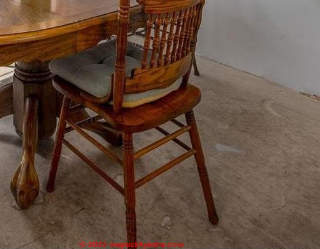 Hi, useful resource here. Thanks for compiling.
We're getting ready move into into our second pre-80's project house. This one I was much smarted and bulk sampled before doing anything.
Hi, useful resource here. Thanks for compiling.
We're getting ready move into into our second pre-80's project house. This one I was much smarted and bulk sampled before doing anything.
The one big query is the best approach for the vinyl flooring backing. The previous owner at some point tried to update the kitchen/dining flooring and has installed laminate to part of it but the entire dining room is bare vinyl backing and the wear layer has been pulled off.
I assume this is the same situation under the floating laminate in the kitchen.
Gathering a sample of this shows that its is incredibly tenaciously stuck down to the wood sub floor. It tests as 30% asbestos content. We wont be ready to remediate this or drywall for a good year so have to live in the house in the mean time. The end plan might be hydronic infloor heat with a polished concrete surface
As I have no idea how long the backing has been exposed, what cleaners or potential bond breaking mess has been applied to the floor, I'm unsure what my best approach is to encapsulate this? Some kind of high adhesion primer like guardz/BIN etc then a decent wear layer paint?
Perfectprimer is not available in my location unfortunately
Or straight to a 3/8 ply glued over top - however this may need to be removed later depending on future flooring which then poses further risk due to all the screw penetrations disturbing the backing. I would also likely pull the laminate and deal with this also as I'm conscious that foot traffic over a floating floor could produce a billow effect and push "contaminated" air from under laminate floor.
thanks in advance for any insight! - On 2022-07-23 by Jonny -
Reply by InspectApedia-911 (mod)
@Jonny,
If you can't get one of the primers recommended for use over asbestos floor remains I would use any primer that you can to coat the surface.
The disturbance or asbestos release from a screw hole or nail hole later will be trivial and comparison.
Then you can cover that with a temporary layer of resilient sheet flooring until you're ready to do something more aggressive.
The new vinyl sheet flooring forms a continuous membrane. There's no meaningful billowing or pumping effect from walking on it but that was a very good thought that you had and is worth keeping in mind for other situations.
I think that if the existing floor surface is reasonably flat and smooth it's better just to lay the resilient directly on top of the primed surface.
That'll make later removal of all of those flooring layers easier.
If necessary you can tack down a quarter round molding around the edges of the floor.
Does this floor tile look like it contains asbestos?
This is an 1920’s house, multiple layers of flooring. We are ripping up the top and and under it is this - does this look like it contains asbestos?
There are two types of tiles. We planned to put subfloor down, then vinyl over that. - On 2022-06-02 by Erin Howell
Reply by InspectApedia-911 (mod)
@Erin Howell,
It's a little hard to see but I think the upper right corner of your photo is showing a light colored "corkstyle" floor tile - quite commonly containing asbestos in the 1950s - 70s.
Use the on page search box to find "CORKSTYLE FLOOR TILES" to do some comparisons.
Your plan sounds exactly right.
Based on records, the house we're buying had asbestos tile covered with ceramic tile - can we remove it?
We've got an offer in on a house built in 1964. Based on records, it most likely had asbestos tile. Ceramic tile (that we do not like) was installed in 2014, but we have no way of knowing if it was laid OVER asbestos tile. We don't want to keep the ceramic tile. Can we safely remove the ceramic tile if it was installed over asbestos tile? - On 2022-03-20 by CSco -
Reply by Inspectapedia Com Moderator - can I remove ceramic tile over asbestos flooring?
@CSco,
If you can remove the ceramic floor tile without disturbing the suspected vinyl asbestos or asphalt asbestos floor tile beneath it, then that will be fine.
However that may not be the case, depending on how much of the ceramic tile adhesive you need to remove before laying your new flooring.
On 2022-03-17 by Britt - my attic floor may contain asbestos sheet flooring; I vacuumed it; Will I develop diseases now?
I moved into a house where there is asbestos sheet flooring, to which my landlord disclosed. My entire attic floor is made with it, and the home was built in the 1920s. I seems to have found the type in an old 1939 catalog.
Anyways, I unknowing about the risk at the time, taped down large chunks that were sitting loosely on top of hard wood planks for flooring. I also vacuumed before I taped the pieces to each other. After learning more about the dangers, I am seriously freaked out. It seemed to have that black stuff underneath the tiles and I read its super dangerous.
My question is, how do I know if ill develop diseases now? Is there any way to find out even though it was minor? Also, my floor is cracking severely in some spots, and curling on some joints. I sleep close to the floor, is this a real threat?
On 2022-03-17 by Inspectapedia Com Moderator - black mastic under asbestos sheet flooring
@Britt,
Try to feel a bet less panic over this question - as that may be more of a health risk than the flooring.
You should of course take this question to your doctor, a doc whom you trust, and listen to her advice.
The floor is not highly friable unless being demolished; While running a conventional vacuum cleaner over it isn't a great idea (a HEPA vacuum would be ok), and while nobody can possibly guess at the actual exposure a person had to airborne dust based on just a text and a photo, it's not likely that you'll develop asbestosis from the situation you described.
Keep in mind that the egregious cases of asbestosis occurred in workers in industrial settings, and perhaps in their families: people who worked in areas where there was so much airborne asbestos that the air was opaque or milky white making it difficult even to see.
Please post or give us links to the 1939 catalog that featured the flooring in your photo.
And then follow the standard advice for reducing the hazard: cover the flooring with new material.
On 2021-10-21 by Steve - dance studio has 9x9 vinyl tile flooring - is it hazardous "as is"?
Hi, my daughters dance studio has 9x9 vinyl tile flooring. I noticed one or two chipped tiles and brought it to the owners attention that they may contain asbestos. She got them checked out and one of the 3 samples tested positive for containing 3% asbestos. All of the mastic samples came back negative.
The company she is working with on it said that given the relative good condition of the floor and the mastic being negative and only 3% asbestos in the tile there is really no health risk and she can leave the floor as is, covering the two chipped tiles with the dance mat (lays over the floor not permanent covering).
The floor looks to be in decent shape but old and dusty/faded a bit but not broken apart of crumbling by any means.
My question is given the wear and tear of hosting dance classes, including tap dancing in that space even on the dance mat, is it true that it is still unlikely to pose a health risk leaving the floor as is?
I confirmed the company she is working with is properly licensed for asbestos testing and program management.
On 2021-10-21 by inspectapedia.com.moderator
@Steve,
Generally the safest approach is to leave such flooring alone and to cover it with a coating or with another layer of flooring.If the flooring has deteriorated to the point of being friable, then the solutions are different.
It doesn’t sound like that’s the case for the dance studio.
Above on this page, we describe using an epoxy coating or a few replacement tiles on a floor in generally good condition and provided that the remaining floor tiles are well-adhered to the floor below.
You can also read more about leaving asbestos floor tiles in place at:
REDUCE THE HAZARD OF ASBESTOS FLOOR TILES
Question: what's the best way to finish cleaning these asbestos-tiled steps before painting with epoxy
2021/10/13 Anonymous by private email:
The pics below are from a home in Media, PA built in 1930. Not sure when the flooring was put on the basement steps
I removed the carpeting from the steps and revealed what looks like vinyl or linoleum underneath. I took the vinyl/linoleum flooring off of three steps before I thought about asbestos.
The adhesive is brown and appears to be water soluble. I'm really freaked out now that I exposed my family to some nasty stuff.
Would it be safe to wet scrape the remaining adhesive off the steps before epoxy painting?
I plan to epoxy paint over the remaining vinyl/linoleum flooring after I remove the carpet on top of it. Does that make sense?
Moderator reply:
Treat the floor and mastic as presumed to contain asbestos if you're not going to have those materials tested.
I suggest taking a look at the advice at ASBESTOS FLOORING LEFT IN PLACE - (the article above on this page)
where we discuss using sealants and how we cleaned the surfaces first
but in general an epoxy paint will bond well to a secure, clean surface - as you'll see in that article.
I'm unclear why we're scraping - perhaps to try to leave a smooth-epoxy-painted surface? Ok,
then you might also want to see
ASBESTOS REMOVAL, WETTING GUIDELINES
Reader follow-up:
Yes, I was thinking of wet scraping the mastic because I wanted a smooth epoxy paint surface.
It seems like it would be safer to just epoxy paint over the remaining mastic after cleaning though right?
Moderator reply:
The nicest job would be to wet-scrape to give a smooth surface as you described, as in your case you intend to leave the epoxy painted surfaces exposed as the finished surface.
If I were planning to install flooring atop the old, cleaned surfaces, I'd simply use one of the asbestos sealant paints we describe in our article series and then install the new flooring.
On 2021-03-26 by Chantal - What is the best way to fill in one or two missing tiles in an asbestos tile floor to be left in place and covered-over?
I want to install vinyl tile over existing asbestos tiles. All tiles are in good condition except for one. What product would be good to patch the one broken tile so that the floor is level?
On 2021-03-26 by (mod) - best way to fill in one or two missing tiles in an asbestos tile floor
@Chantal, thanks for a helpful question that I'd re-phrase as
What is the best way to fill in one or two missing tiles in an asbestos tile floor to be left in place and covered-over?
Simple solution-1: with the surface where the tile was lost is clean and free from oil or grease, simply glue down any floor tile of the right dimensions and of the same thickness as the originals.
Simple solutution-2: with the surface where the tile was lost is clean and free from oil or grease, and using a wide blade (8-12") drywall taping knife or blade, fill the low area with an adhering filler like Dash Patch or Durham's Rock Hard Water Putty. You can see photos of those products at https://inspectapedia.com/interiors/Fiberboard-Panel-Repair.php FIBERBOARD PANEL REPAIR
At https://inspectapedia.com/interiors/Floor-Tile-Base-Leveling.php FLOOR TILE BASE LEVELING we discuss using fillers and leveling compound to fill in the spots where a floor tile has been lost or removed.
Also see https://inspectapedia.com/hazmat/Asbestos_Floor_Sealants.php FLOORING ADHESIVE MASTIC SEALANTS - if you need to glue down new floor or add a leveling compound over old tile mastic
Also see https://inspectapedia.com/hazmat/Asbestos_Floor_Sealants.php FLOORING ADHESIVE MASTIC SEALANTS - if you need to glue down new floor or add a leveling compound over old tile mastic and where you're worried that old exposed mastic may prevent adhesion of new flooring.
...
Continue reading at ASBESTOS FLOORING REMOVAL GUIDE or select a topic from the closely-related articles below, or see the complete ARTICLE INDEX.
Or see ASBESTOS FLOORING LEFT IN PLACE FAQs - questions & answers posted originally at this page.
Or see these
Recommended Articles
- ASBESTOS-CONTAINING ADHESIVES
- ASBESTOS ENCAPSULANTS & SEALERS - coatings, encapsulants, fiber release control for asbestos containing materials
- ASBESTOS FLOORING HAZARD REDUCTION - home
- ASBESTOS FLOORING IDENTIFICATION
- ASBESTOS FLOORING HAZARD LEVEL ASSESSMENT
- ASBESTOS DISPOSAL REGULATIONS
- ASBESTOS FLOORING LEFT IN PLACE
- ASBESTOS FLOORING REMOVAL GUIDE
- ASBESTOS LEFT in PLACE in BUILDINGS - MANAGEMENT GUIDES - codes, regulations, procedures
- ASBESTOS REMOVAL, WETTING GUIDELINES
- DOES THIS FLOOR CONTAIN ASBESTOS? - 5 easy questions to tell if your FLOOR probably contains asbestos -
- FLOOR TILE BASE LEVELING describes using leveling compounds or filler-tiles before flooring-over asbestos tile floors
- FLOORING ADHESIVE MASTIC SEALANTS - if you need to glue down new floor or add a leveling compound over old tile mastic
- POURED-IN-PLACE FLOORING, RESILIENT - pour on a whole new floor surface
- RESILIENT FLOORING VINYL or CORK installation
Suggested citation for this web page
ASBESTOS FLOORING LEFT IN PLACE at InspectApedia.com - online encyclopedia of building & environmental inspection, testing, diagnosis, repair, & problem prevention advice.
Or see this
INDEX to RELATED ARTICLES: ARTICLE INDEX to ASBESTOS HAZARDS
Or use the SEARCH BOX found below to Ask a Question or Search InspectApedia
Ask a Question or Search InspectApedia
Questions & answers on how to minimize the risk of asbestos contamination in a building due to the presence of asbestos-containing floor tiles or asbestos-suspect floor tile coverings.
Try the search box just below, or if you prefer, post a question or comment in the Comments box below and we will respond promptly.
Search the InspectApedia website
Note: appearance of your Comment below may be delayed: if your comment contains an image, photograph, web link, or text that looks to the software as if it might be a web link, your posting will appear after it has been approved by a moderator. Apologies for the delay.
Only one image can be added per comment but you can post as many comments, and therefore images, as you like.
You will not receive a notification when a response to your question has been posted.
Please bookmark this page to make it easy for you to check back for our response.
IF above you see "Comment Form is loading comments..." then COMMENT BOX - countable.ca / bawkbox.com IS NOT WORKING.
In any case you are welcome to send an email directly to us at InspectApedia.com at editor@inspectApedia.com
We'll reply to you directly. Please help us help you by noting, in your email, the URL of the InspectApedia page where you wanted to comment.
Citations & References
In addition to any citations in the article above, a full list is available on request.
- "Asbestos in your home or at work," Forsyth County Environmental Affairs Department, Winston-Salem NC 12/08
- "Asbestos Floor Tile Removal", the University of Minnesota's advice on removing VAT (vinyl asbestos or asphalt asbestos floor tile) can be read in detail at www.health.state.mn.us/divs/eh/asbestos/floortile/index.html
- EPA, ASBESTOS IN YOUR HOME [PDF] - U.S. EPA, Exposure Evaluation Division, Office of Toxic Substances, Office of Pesticides and Toxic Substances, U.S. Environmental Protection Agency, Washington,D.C. 20460
- Resilient Floor Covering Institute, 1030 15th St. NW, suite 350, Washington D.C.
- ASBESTOS REGULATIONS FOR SCHOOLS (the Asbestos Hazard Emergency Response Act, "AHERA") [PDF] (96 pp, 589k), web search 08/17/2010, original source: http://www.epa.gov/asbestos/pubs/2003pt763.pdf,
- Asbestos Regulations: State asbestos regulatory agencies (5 pp, 17k) (original source http://www.epa.gov/asbestos/pubs/statecontactsapril2009.pdf ) for information on how to find an accredited asbestos professional.
- "Asbestos Floor Tile Removal Guide & Instructions - copy on file as Asbestos_Floor_Tile_Removal_MDH.pdf ] - ", Minnesota Department of Health, retrieved 12/7/2010, original source: http://www.health.state.mn.us/divs/eh/asbestos/floortile/index.html
- David Grudzinski, Advantage Home Inspections, is a professional home inspector in Cranston, RI. 02910. He can be reached at 401-935-6547, fax- 401-490-0607 or by email to contact/us@advantagehomeinspections.us 04/26/2009
- EPA Guidance for Controlling Asbestos-Containing Materials in buildings, NIAST, National Institute on Abatement Sciences & Technology, [republishing EPA public documents] 1985 ed., Exposure Evaluation Division, Office of Toxic Substances, Office of Pesticides and Toxic Substances, U.S. Environmental Protection Agency, Washington,D.C. 20460
- EVER WEAR TILE CO is currently (2009) in the Terrazzo, Tile, Marble, and Mosaic Work industry in Fallon, NV. 775) 423-6221. [We do not know the company history nor whether there is an association with EverWear vinyl asbestos floor tiles discussed in this article.]
- Asbestos Identification, Walter C.McCrone, McCrone Research Institute, Chicago, IL.1987 ISBN 0-904962-11-3. Dr. McCrone literally "wrote the book" on asbestos identification procedures which formed the basis for current work by asbestos identification laboratories.
- Stanton, .F., et al., National Bureau of Standards Special Publication 506: 143-151
- Pott, F., Staub-Reinhalf Luft 38, 486-490 (1978) cited by McCrone
- US EPA ASBESTOS NESHAP ADEQUATELY WET GUIDANCE, EPA340/1-90-019, [PDF] December 1990, U.S. ENVIRONMENTAL PROTECTION AGENCY, Office of Air Quality Planning and Standards, Stationary Source Compliance Division, Washington, DC 20460, original web source: http://www.epa.gov/region04/air/asbestos/awet.htm
- EPA Guidance for Controlling Asbestos-Containing Materials in buildings, NIAST, National Institute on Abatement Sciences & Technology, [republishing EPA public documents] 1985 ed., Exposure Evaluation Division, Office of Toxic Substances, Office of Pesticides and Toxic Substances, U.S. Environmental Protection Agency, Washington,D.C. 20460
- In addition to citations & references found in this article, see the research citations given at the end of the related articles found at our suggested
CONTINUE READING or RECOMMENDED ARTICLES.
- Carson, Dunlop & Associates Ltd., 120 Carlton Street Suite 407, Toronto ON M5A 4K2. Tel: (416) 964-9415 1-800-268-7070 Email: info@carsondunlop.com. Alan Carson is a past president of ASHI, the American Society of Home Inspectors.
Thanks to Alan Carson and Bob Dunlop, for permission for InspectAPedia to use text excerpts from The HOME REFERENCE BOOK - the Encyclopedia of Homes and to use illustrations from The ILLUSTRATED HOME .
Carson Dunlop Associates provides extensive home inspection education and report writing material. In gratitude we provide links to tsome Carson Dunlop Associates products and services.


